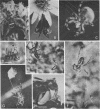Abstract
Field observations showed orb-weaving spiders (Argiope spp.) to undergo leg autotomy if they are stung in a leg by venomous insect prey (Phymata fasciata). The response occurs within seconds, before the venom can take lethal action by spread to the body of the spiders. Autotomy is induced also by honeybee venom and wasp venom, as well as by several venom components (serotonin, histamine, phospholipase A2, melittin) known to be responsible for the pain characteristically elicited by venom injection in humans. The sensing mechanism by which spiders detect injected harmful chemicals such as venoms therefore may be fundamentally similar to the one in humans that is coupled with the perception of pain.
Keywords: chemical defense, chemoreception, coevolution, pharmacology
Full text
PDF



Images in this article
Selected References
These references are in PubMed. This may not be the complete list of references from this article.
- Chahl L. A., Kirk E. J. Toxins which produce pain. Pain. 1975 Mar;1(1):3–49. doi: 10.1016/0304-3959(75)90003-2. [DOI] [PubMed] [Google Scholar]
- Schmidt J. O. Biochemistry of insect venoms. Annu Rev Entomol. 1982;27:339–368. doi: 10.1146/annurev.en.27.010182.002011. [DOI] [PubMed] [Google Scholar]



